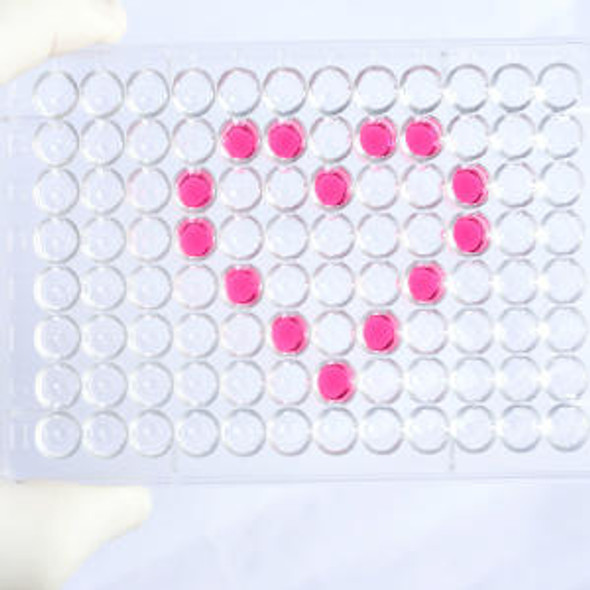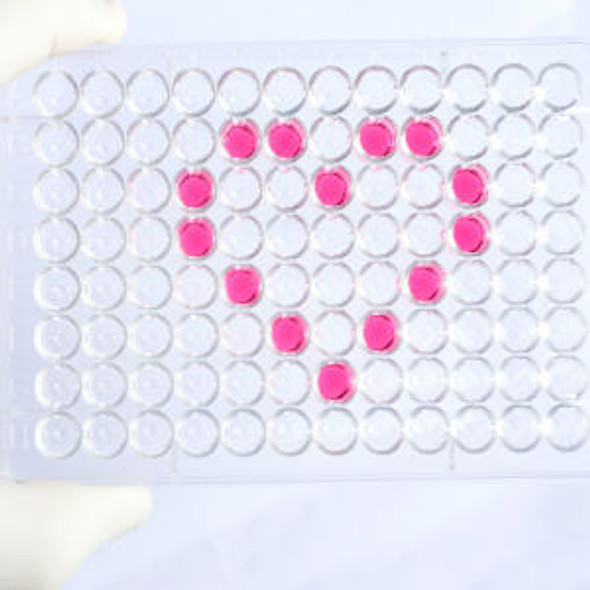Human UBB / Ubiquitin-B ELISA Kit
- SKU:
- HUFI00526
- Product Type:
- ELISA Kit
- Size:
- 96 Assays
- Uniprot:
- P0CG47
- Sensitivity:
- 0.188ng/ml
- Range:
- 0.313-20ng/ml
- ELISA Type:
- Sandwich
- Synonyms:
- UBB, polyubiquitin B, polyubiquitin-B, RPS27A, UBA52, UBC, ubiquitin B, Ubiquitin+1
- Reactivity:
- Human
- Research Area:
- Cell Biology
Description
Human UBB / Ubiquitin-B ELISA
UBB / Ubiquitin-B has a major role in targeting cellular proteins for degradation by the 26S proteosome. UBB / Ubiquitin-B is also involved in the maintenance of chromatin structure, the regulation of gene expression, and the stress response. Mutations in UBB / Ubiquitin-B have been linked with diseases such as Alzheimer's disease, Down syndrome and Cleft Palate. The Assay Genie Human UBB/Ubiquitin-B ELISA is a highly sensitive assay for the quantitative measurement of UBB/Ubiquitin-B in serum, blood, plasma, cell culture supernatant and tissue samples.
| Product Name: | Human UBB / Ubiquitin-B ELISA Kit |
| Product Code: | HUFI00526 |
| Size: | 96 Assays |
| Alias: | UBB, polyubiquitin B, polyubiquitin-B, RPS27A, UBA52, UBC, ubiquitin B, Ubiquitin+1 |
| Detection method: | Sandwich ELISA, Double Antibody |
| Application: | This immunoassay kit allows for the in vitro quantitative determination of Human UBB concentrations in serum plasma and other biological fluids. |
| Sensitivity: | 0.188ng/ml |
| Range: | 0.313-20ng/ml |
| Storage: | 4°C for 6 months |
| Note: | For Research Use Only |
| Recovery: | Matrices listed below were spiked with certain level of Human UBB and the recovery rates were calculated by comparing the measured value to the expected amount of Human UBB in samples. | ||||||||||||||||
| |||||||||||||||||
| Linearity: | The linearity of the kit was assayed by testing samples spiked with appropriate concentration of Human UBB and their serial dilutions. The results were demonstrated by the percentage of calculated concentration to the expected. | ||||||||||||||||
| |||||||||||||||||
| CV(%): | Intra-Assay: CV<8% Inter-Assay: CV<10% |
| Component | Quantity | Storage |
| ELISA Microplate (Dismountable) | 8×12 strips | 4°C for 6 months |
| Lyophilized Standard | 2 | 4°C/-20°C |
| Sample/Standard Dilution Buffer | 20ml | 4°C |
| Biotin-labeled Antibody(Concentrated) | 120ul | 4°C (Protect from light) |
| Antibody Dilution Buffer | 10ml | 4°C |
| HRP-Streptavidin Conjugate(SABC) | 120ul | 4°C (Protect from light) |
| SABC Dilution Buffer | 10ml | 4°C |
| TMB Substrate | 10ml | 4°C (Protect from light) |
| Stop Solution | 10ml | 4°C |
| Wash Buffer(25X) | 30ml | 4°C |
| Plate Sealer | 5 | - |
Other materials and equipment required:
- Microplate reader with 450 nm wavelength filter
- Multichannel Pipette, Pipette, microcentrifuge tubes and disposable pipette tips
- Incubator
- Deionized or distilled water
- Absorbent paper
- Buffer resevoir
| Uniprot | P0CG47 |
| UniProt Protein Function: | UBB: Ubiquitin exists either covalently attached to another protein, or free (unanchored). When covalently bound, it is conjugated to target proteins via an isopeptide bond either as a monomer (monoubiquitin), a polymer linked via different Lys residues of the ubiquitin (polyubiquitin chains) or a linear polymer linked via the initiator Met of the ubiquitin (linear polyubiquitin chains). Polyubiquitin chains, when attached to a target protein, have different functions depending on the Lys residue of the ubiquitin that is linked: Lys-6-linked may be involved in DNA repair; Lys-11-linked is involved in ERAD (endoplasmic reticulum-associated degradation) and in cell-cycle regulation; Lys-29-linked is involved in lysosomal degradation; Lys-33-linked is involved in kinase modification; Lys-48-linked is involved in protein degradation via the proteasome; Lys-63-linked is involved in endocytosis, DNA-damage responses as well as in signaling processes leading to activation of the transcription factor NF-kappa-B. Linear polymer chains formed via attachment by the initiator Met lead to cell signaling. Ubiquitin is usually conjugated to Lys residues of target proteins, however, in rare cases, conjugation to Cys or Ser residues has been observed. When polyubiquitin is free (unanchored-polyubiquitin), it also has distinct roles, such as in activation of protein kinases, and in signaling. Belongs to the ubiquitin family. |
| UniProt Protein Details: | Protein type:Apoptosis; Ubiquitin-like modifier; Cell development/differentiation; Cell cycle regulation; Transcription regulation; Motility/polarity/chemotaxis Chromosomal Location of Human Ortholog: 17p12-p11.2 Cellular Component: nucleoplasm; neuron projection; cell soma; mitochondrion; plasma membrane; endosome membrane; cytosol Molecular Function:protein binding Biological Process: circadian rhythm; I-kappaB kinase/NF-kappaB cascade; negative regulation of ubiquitin-protein ligase activity during mitotic cell cycle; protein polyubiquitination; nerve growth factor receptor signaling pathway; viral reproduction; positive regulation of apoptosis; activation of MAPK activity; stress-activated MAPK cascade; toll-like receptor 3 signaling pathway; endosome transport; T cell receptor signaling pathway; DNA damage response, signal transduction by p53 class mediator resulting in cell cycle arrest; activation of NF-kappaB transcription factor; mitochondrion transport along microtubule; regulation of apoptosis; toll-like receptor 5 signaling pathway; antigen processing and presentation of peptide antigen via MHC class I; regulation of mitochondrial membrane potential; transforming growth factor beta receptor signaling pathway; JNK cascade; antigen processing and presentation of exogenous peptide antigen via MHC class I; G2/M transition of mitotic cell cycle; toll-like receptor 4 signaling pathway; regulation of interferon type I production; glycogen biosynthetic process; fibroblast growth factor receptor signaling pathway; positive regulation of I-kappaB kinase/NF-kappaB cascade; transcription, DNA-dependent; antigen processing and presentation of exogenous peptide antigen via MHC class I, TAP-dependent; glucose metabolic process; Notch receptor processing; virus assembly; toll-like receptor 2 signaling pathway; carbohydrate metabolic process; viral protein processing; positive regulation of transcription from RNA polymerase II promoter; toll-like receptor 9 signaling pathway; negative regulation of interferon type I production; negative regulation of apoptosis; G1/S transition of mitotic cell cycle; positive regulation of ubiquitin-protein ligase activity during mitotic cell cycle; negative regulation of epidermal growth factor receptor signaling pathway; apoptosis; pathogenesis; negative regulation of transcription from RNA polymerase II promoter; viral infectious cycle; toll-like receptor 10 signaling pathway; anaphase-promoting complex-dependent proteasomal ubiquitin-dependent protein catabolic process; positive regulation of interferon type I production; transmembrane transport; epidermal growth factor receptor signaling pathway; transcription initiation from RNA polymerase II promoter; Notch signaling pathway; cytokine and chemokine mediated signaling pathway; MyD88-independent toll-like receptor signaling pathway; DNA repair; MyD88-dependent toll-like receptor signaling pathway; regulation of ubiquitin-protein ligase activity during mitotic cell cycle; toll-like receptor signaling pathway; innate immune response; gene expression; mitotic cell cycle; negative regulation of transforming growth factor beta receptor signaling pathway; neurite morphogenesis Disease: Cleft Palate, Isolated |
| NCBI Summary: | This gene encodes ubiquitin, one of the most conserved proteins known. Ubiquitin has a major role in targeting cellular proteins for degradation by the 26S proteosome. It is also involved in the maintenance of chromatin structure, the regulation of gene expression, and the stress response. Ubiquitin is synthesized as a precursor protein consisting of either polyubiquitin chains or a single ubiquitin moiety fused to an unrelated protein. This gene consists of three direct repeats of the ubiquitin coding sequence with no spacer sequence. Consequently, the protein is expressed as a polyubiquitin precursor with a final amino acid after the last repeat. An aberrant form of this protein has been detected in patients with Alzheimer's disease and Down syndrome. Pseudogenes of this gene are located on chromosomes 1, 2, 13, and 17. Alternative splicing results in multiple transcript variants. [provided by RefSeq, Aug 2013] |
| UniProt Code: | P0CG47 |
| NCBI GenInfo Identifier: | 302595875 |
| NCBI Gene ID: | 7314 |
| NCBI Accession: | P0CG47.1 |
| UniProt Secondary Accession: | P0CG47,P0CG48, P62979, P62987, |
| UniProt Related Accession: | P0CG47 |
| Molecular Weight: | |
| NCBI Full Name: | Polyubiquitin-B |
| NCBI Synonym Full Names: | ubiquitin B |
| NCBI Official Symbol: | UBB |
| NCBI Official Synonym Symbols: | HEL-S-50 |
| NCBI Protein Information: | polyubiquitin-B |
| UniProt Protein Name: | Polyubiquitin-B |
| Protein Family: | Ubiquilin |
| UniProt Gene Name: | UBB |
| UniProt Entry Name: | UBB_HUMAN |
*Note: Protocols are specific to each batch/lot. For the correct instructions please follow the protocol included in your kit.
Before adding to wells, equilibrate the SABC working solution and TMB substrate for at least 30 min at 37°C. When diluting samples and reagents, they must be mixed completely and evenly. It is recommended to plot a standard curve for each test.
| Step | Protocol |
| 1. | Set standard, test sample and control (zero) wells on the pre-coated plate respectively, and then, record their positions. It is recommended to measure each standard and sample in duplicate. Wash plate 2 times before adding standard, sample and control (zero) wells! |
| 2. | Aliquot 0.1ml standard solutions into the standard wells. |
| 3. | Add 0.1 ml of Sample / Standard dilution buffer into the control (zero) well. |
| 4. | Add 0.1 ml of properly diluted sample ( Human serum, plasma, tissue homogenates and other biological fluids.) into test sample wells. |
| 5. | Seal the plate with a cover and incubate at 37 °C for 90 min. |
| 6. | Remove the cover and discard the plate content, clap the plate on the absorbent filter papers or other absorbent material. Do NOT let the wells completely dry at any time. Wash plate X2. |
| 7. | Add 0.1 ml of Biotin- detection antibody working solution into the above wells (standard, test sample & zero wells). Add the solution at the bottom of each well without touching the side wall. |
| 8. | Seal the plate with a cover and incubate at 37°C for 60 min. |
| 9. | Remove the cover, and wash plate 3 times with Wash buffer. Let wash buffer rest in wells for 1 min between each wash. |
| 10. | Add 0.1 ml of SABC working solution into each well, cover the plate and incubate at 37°C for 30 min. |
| 11. | Remove the cover and wash plate 5 times with Wash buffer, and each time let the wash buffer stay in the wells for 1-2 min. |
| 12. | Add 90 µl of TMB substrate into each well, cover the plate and incubate at 37°C in dark within 10-20 min. (Note: This incubation time is for reference use only, the optimal time should be determined by end user.) And the shades of blue can be seen in the first 3-4 wells (with most concentrated standard solutions), the other wells show no obvious color. |
| 13. | Add 50 µl of Stop solution into each well and mix thoroughly. The color changes into yellow immediately. |
| 14. | Read the O.D. absorbance at 450 nm in a microplate reader immediately after adding the stop solution. |
When carrying out an ELISA assay it is important to prepare your samples in order to achieve the best possible results. Below we have a list of procedures for the preparation of samples for different sample types.
| Sample Type | Protocol |
| Serum | If using serum separator tubes, allow samples to clot for 30 minutes at room temperature. Centrifuge for 10 minutes at 1,000x g. Collect the serum fraction and assay promptly or aliquot and store the samples at -80°C. Avoid multiple freeze-thaw cycles. If serum separator tubes are not being used, allow samples to clot overnight at 2-8°C. Centrifuge for 10 minutes at 1,000x g. Remove serum and assay promptly or aliquot and store the samples at -80°C. Avoid multiple freeze-thaw cycles. |
| Plasma | Collect plasma using EDTA or heparin as an anticoagulant. Centrifuge samples at 4°C for 15 mins at 1000 × g within 30 mins of collection. Collect the plasma fraction and assay promptly or aliquot and store the samples at -80°C. Avoid multiple freeze-thaw cycles. Note: Over haemolysed samples are not suitable for use with this kit. |
| Urine & Cerebrospinal Fluid | Collect the urine (mid-stream) in a sterile container, centrifuge for 20 mins at 2000-3000 rpm. Remove supernatant and assay immediately. If any precipitation is detected, repeat the centrifugation step. A similar protocol can be used for cerebrospinal fluid. |
| Cell culture supernatant | Collect the cell culture media by pipette, followed by centrifugation at 4°C for 20 mins at 1500 rpm. Collect the clear supernatant and assay immediately. |
| Cell lysates | Solubilize cells in lysis buffer and allow to sit on ice for 30 minutes. Centrifuge tubes at 14,000 x g for 5 minutes to remove insoluble material. Aliquot the supernatant into a new tube and discard the remaining whole cell extract. Quantify total protein concentration using a total protein assay. Assay immediately or aliquot and store at ≤ -20 °C. |
| Tissue homogenates | The preparation of tissue homogenates will vary depending upon tissue type. Rinse tissue with 1X PBS to remove excess blood & homogenize in 20ml of 1X PBS (including protease inhibitors) and store overnight at ≤ -20°C. Two freeze-thaw cycles are required to break the cell membranes. To further disrupt the cell membranes you can sonicate the samples. Centrifuge homogenates for 5 mins at 5000xg. Remove the supernatant and assay immediately or aliquot and store at -20°C or -80°C. |
| Tissue lysates | Rinse tissue with PBS, cut into 1-2 mm pieces, and homogenize with a tissue homogenizer in PBS. Add an equal volume of RIPA buffer containing protease inhibitors and lyse tissues at room temperature for 30 minutes with gentle agitation. Centrifuge to remove debris. Quantify total protein concentration using a total protein assay. Assay immediately or aliquot and store at ≤ -20 °C. |
| Breast Milk | Collect milk samples and centrifuge at 10,000 x g for 60 min at 4°C. Aliquot the supernatant and assay. For long term use, store samples at -80°C. Minimize freeze/thaw cycles. |
Fill out our quote form below and a dedicated member of staff will get back to you within one working day!






